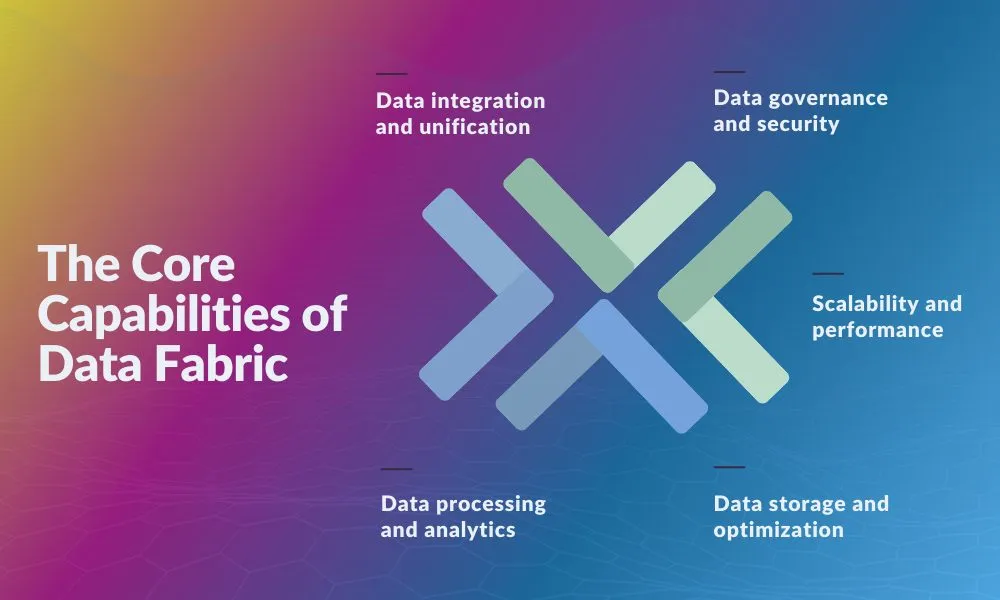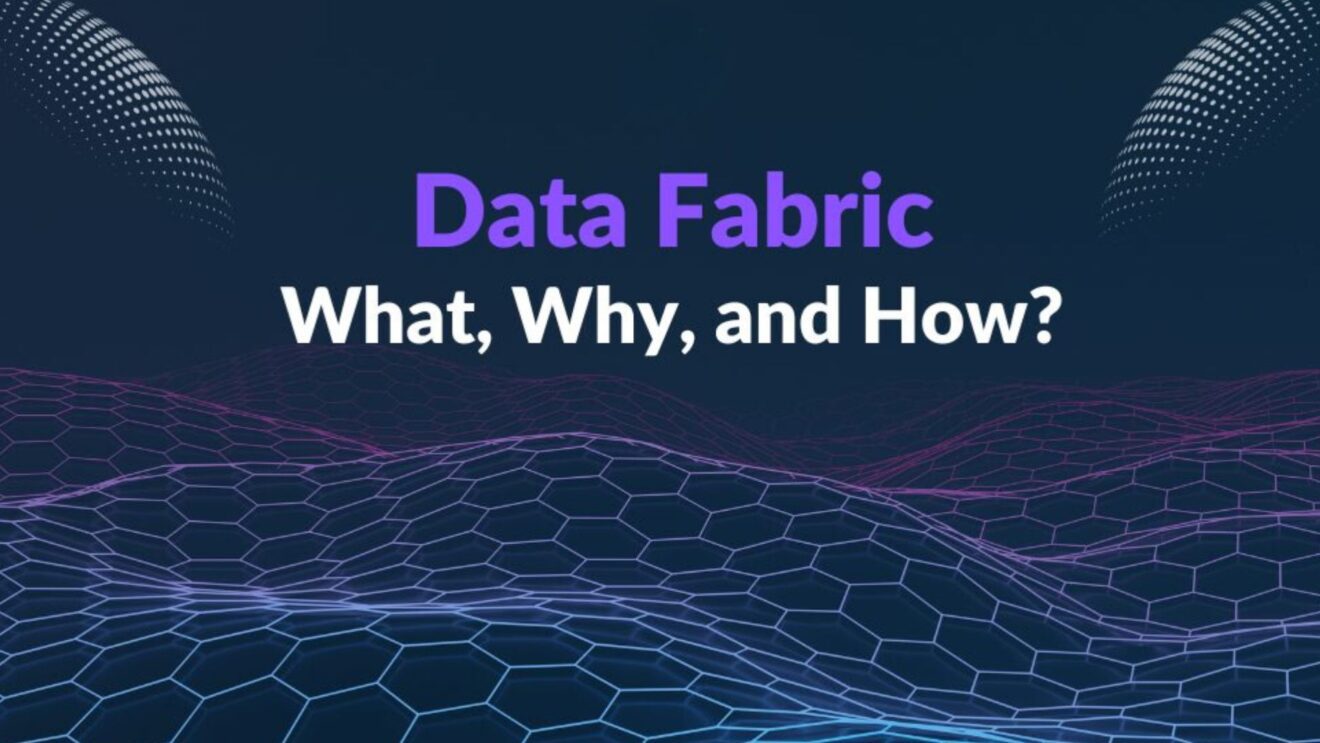A comprehensive guide to what is Data Fabric, its challenges, and key capabilities.
By 2024 data fabric deployments will quadruple efficiency in data utilization while cutting human-driven data management tasks in half.
Gartner
As businesses embark on the digital journey, they find themselves navigating through choppy waters, where innovation and agility are the keys to success. The constant evolution of the digital landscape requires them to keep pace with the latest technological trends and stay ahead of the competition. Among the many solutions that have emerged, Data Fabric is one that has captured the imagination of businesses across the globe.
It is not just a buzzword but a transformative technology that has disrupted the market. Its versatility and flexibility have made it a vital tool for organizations to manage their data and accelerate their digital transformation. This innovative approach has been identified as one of the top technology trends in 2022, and it continues to gain momentum in 2023.
According to industry experts, the global data fabric market is projected to experience a compound annual growth rate (CAGR) of 21.2% from 2022 to 2030. In 2021, the market size was estimated at USD 1,399.7 million, which indicates a growing demand for this technology.
In this article, we’ll talk about everything you need to know about the architecture. What are the key capabilities? The benefits of the operational data fabric and how to catapult your business with the data fabric approach.
What is Data Fabric?
Data Fabric is an architectural approach that enables businesses to integrate, manage, and analyze data from multiple sources in real-time, using the power of AI and ML. It acts as a bridge between IT teams and business workers, empowering them to work collaboratively and drive growth.
In other words, it is an architecture for managing data that offers a consolidated perspective of an organization’s data, regardless of its storage location. With Data Fabrics, organizations can more efficiently access, manage, and share their data, regardless of where it is stored.
To put it briefly, a data fabric architecture enables businesses to unify, govern, and orchestrate data seamlessly, improving its availability and accessibility.
Why Data Fabric?
With the present data overflow scenario, businesses are constantly facing the challenge of managing and analyzing massive amounts of data. This is where Data Fabrics come into play – they provide a comprehensive solution for collecting, processing and analyzing data.
It helps businesses manage data effectively and accelerate digital transformation.
It helps to upscale business operations in the following ways:
- Helps businesses manage data effectively and accelerate digital transformation: They are highly scalable, which means that businesses can manage their data growth with ease while keeping up with the latest technological advancements. This helps businesses stay competitive in their respective industries.
- Facilitates collaboration and breaks down silos across different departments: Businesses can break down silos and collaborate more effectively across different departments with the data fabric approach. This not only improves the overall efficiency of the organization but also leads to faster decision-making and enhanced productivity.
- Real-time insights: Empowers businesses to make data-driven decisions by providing real-time insights into their data. This is crucial for staying ahead in today’s competitive landscape.
- Significantly reducing data management efforts: Offers significant value through its analytical capabilities, reducing data management efforts by up to 70%. This accelerates the time it takes to deliver value, leading to a better ROI.
- Automation: Provides automation and collaboration opportunities, allowing businesses to automate data governance, engineering, and protection work. This not only saves time and effort but also ensures accuracy and consistency in data management.
In summary, Data Fabric is a must-have tool for businesses looking to accelerate their digital transformation journey, stay competitive, and make data-driven decisions.
The Key Capabilities

It aids in ensuring that data is reliable and comprehensive and generates insights that drive business success. This critical technology can lead to improved flexibility and performance, as well as cost savings for finance, ultimately unlocking business and data value.
A good solution should offer the following capabilities, to be considered comprehensive:
1. Data integration and unification
- Seamless data ingestion from various sources and formats (structured, semi-structured, and unstructured)
- Data cataloging for a consistent and unified view of data across the organization
- Data transformation and enrichment to improve data quality and usability
2. Data governance and security
- Data lineage tracking to understand data origin and transformation history
- Access control and role-based permissions to protect sensitive information
- Data classification, encryption, and masking to ensure compliance with industry regulations
3. Data processing and analytics
- Real-time data processing for immediate insights and decision-making
- Advanced analytics with machine learning and AI-driven techniques
- Support for various analytics tools, frameworks, and languages (e.g., SQL, Python, R)
4. Data storage and optimization
- Intelligent data tiering and lifecycle management to optimize storage costs
- Data deduplication, compression, and caching to improve storage efficiency
- Support for multiple storage technologies and platforms (on-premises, cloud, hybrid)
5. Scalability and performance
- Elastic scalability to handle increasing data volumes, users, and workloads
- High availability and fault tolerance to ensure continuous data access
- Performance optimization techniques, such as indexing and query optimization, to speed up data retrieval and processing
Operationalize your Data with Apica

Businesses need a data fabric to overcome the challenges they face with data management. Limited data access can be addressed by using it to break down data silos and provide a centralized platform for data management.
Multiple data sources and types can be integrated effectively with a data fabric, enabling businesses to derive valuable insights from their data.
Furthermore, data integration complexities can be streamlined with a data fabric that automates ETL processes and reduces the risk of errors. By adopting a data fabric, businesses can improve their data accessibility, integration, and analysis capabilities, ultimately leading to better decision-making and improved business outcomes.
Apica’s Operational Data Fabric is an approach that focuses on streamlining data operations, ensuring that data is available when it is needed and where it is needed. This approach helps businesses to optimize their operations, reduce costs, and improve efficiency.
Although “Operational Data Fabric” might sound like a mouthful, its remarkable benefits are worth exploring and utilizing.
apica.io is the prime example of operating on an operational data fabric architecture. Apica unites all real-time operational data, including business, observability, security, and network data using its innovative zero-archive architecture.
This approach enables Apica to provide instant insights, control, and compliance at scale, offering such benefits as:
- Simplified Data Integration
- Real-time Data Processing
- Robust Data Governance
- High Scalability
- Utmost Flexibility
In conclusion, Data Fabric is a game-changer transforming how businesses manage their data. It offers tools to accelerate digital transformation and federated observability.
As businesses continue to embrace the digital age, its implementations will play a critical role in driving success. Any business that wants to scale must take advantage of the significant capabilities of data fabric today.
In a Glimpse
- Data Fabric is an architecture for managing data that provides a consolidated perspective of an organization’s data, regardless of its storage location.
- Data Fabric is a crucial tool for businesses looking to accelerate their digital transformation journey, stay competitive, and make data-driven decisions.
- Data Fabric offers significant value through its analytical capabilities, reducing data management efforts by up to 70% and accelerating the time it takes to deliver value, leading to a better ROI.
- A good data fabric solution should offer data integration and unification, data governance and security, data processing and analytics, and scalability and performance capabilities.
- Apica’s Operational Data Fabric streamlines data operations and helps businesses optimize their operations, reduce costs, and improve efficiency.
- Businesses that want to scale must take advantage of the significant capabilities of data fabric today.











